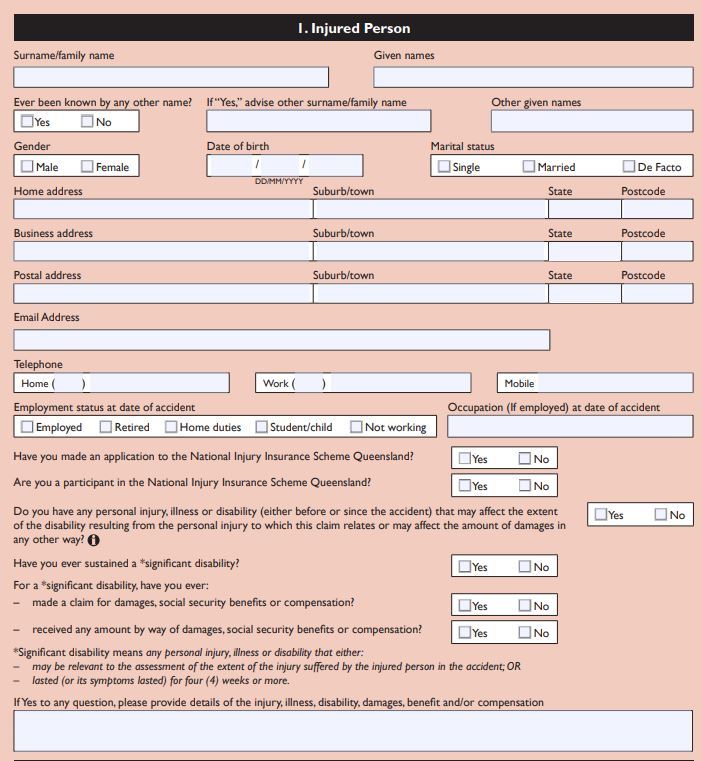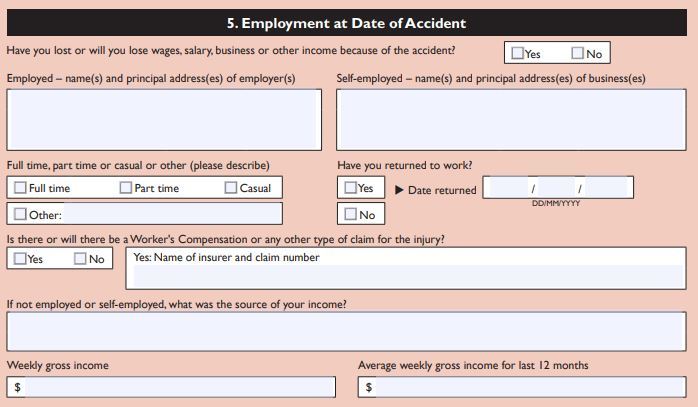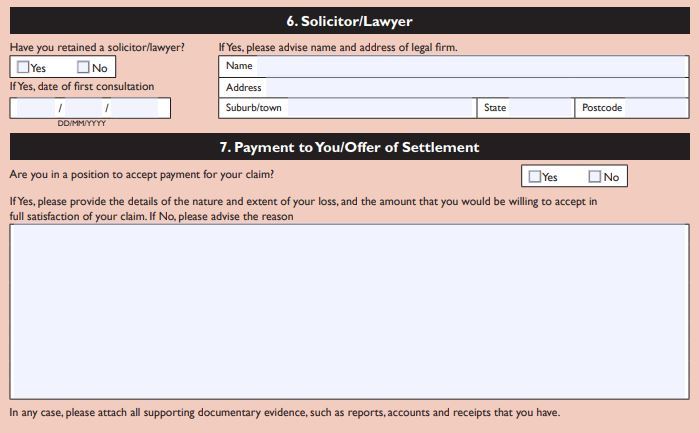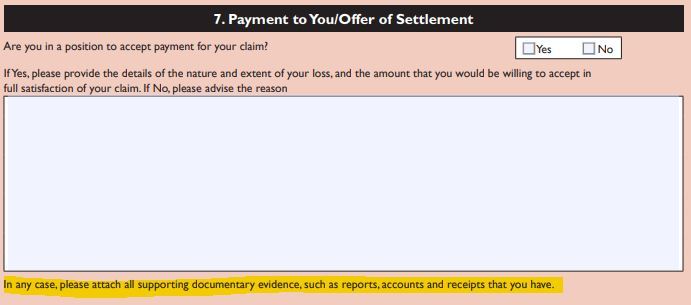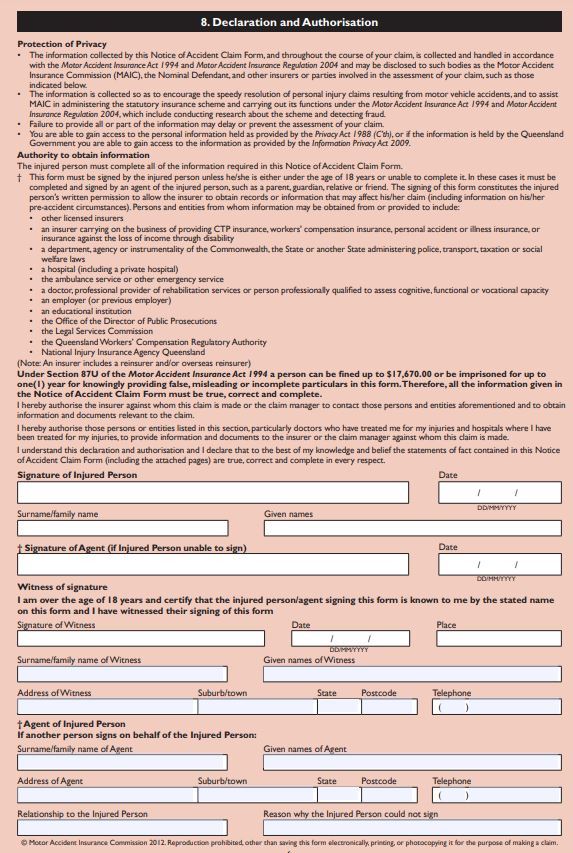This video and it's content are property of MCW Legal™ as it transitions through a re-brand to Sure Legal™.
HOW TO COMPLETE YOUR PERSONAL DETAILS
on a notice of accident claim form.
Lesson Essentials
Essential Resources
Linked Videos
Time Stamps
Lesson Contents
Introduction
We can all agree that swapping personal details after we've been injured in a motor vehicle accident is pretty common.
It seems that after an accident there is a never ending request for our personal information. Particularly if we are making an insurance claim.
One of the places we will be required to divulge personal information about ourselves is on the Notice of Accident Claim (NOAC) Form. This form needs to be submitted to the CTP insurer of the at-fault driver so that you can be compensated for your injuries.
This form must be completed very, very carefully.
The ‘personal details’ section contains some areas that can trip you up if not filled out correctly.Delay, Deny, Defend.
Often, the insurer can delay or deny your claim based on parts of the form that are not filled in properly.
It can make us feel pretty intimidated and angry even, but we don't need to surrender to the red tape. We don’t need to give in to the bureaucracy.
We just need to make sure we leave nothing out. And the best way to do that is to go through a step-by-step process. If you follow this process and submit your NOAC form, you can be extremely confident that it won't be getting sent back (or knocked back) because parts of it were incomplete.
The aim of this video and blog post is to give you that step-by-step guide to filling in the form. It will enable you to access the full amount of compensation that you are entitled to.
KISS your NOAC
We will break this blog post down into three stages.
We understand how people who are victim of a car accident feel like they're being punished with paperwork, so we aim to keep this as easy, simple, and as practical as possible. We will apply the KISS method (Keep It Simple Stupid).
The KISS method we're going to show you for completing the personal details of the NOAC form is exactly what we use in our legal practice. We have used it to get the right results for thousands of clients.
We'll get started with the first step, and that step is to record your personal details. You'll need to have a copy of the NOAC form. Print out a couple of copies so that you have one that you can use as a working copy.
STAGE 1: Filling In Your Personal Details
You'll need to go to Secton 1 of the NOAC form, and here, we will fill in our details about the accident. This is pretty straightforward and self-explanatory, but let's have a look at it anyway.
This is the part of the form you'll be filling out:
The first thing you need to put in is your surname and your given name.
You will then list if you have you been known by any other names, what your gender is, date of birth, and marital status. These things will allow you to be identified.
Next is your home address, business address, and postal address (where applicable), and finally, your email address. That's the contact for sending you any correspondence.
Finally, your telephone number so that the insurer and other people can get in touch with you.
Do not chop and change your story about your work history.
Lastly, the employment details at the time of the accident.
This is very important.
This is one of the areas we have to keep consistent right through the claims process.
Your employment details need to align everywhere on the form.
You need to get this right, because it can have a large impact on your claim.
Do NOT chop and change your story about your employment history.
So go ahead now and fill in the injured person section, and when you've done that, it's time to move on to the next stage.
STAGE 2: Be Nice to your Boss
You'll need to now go to Section 5 of the NOAC form, and here, we fill in our details about our employment at the time of the accident.
This also is pretty straightforward and self-explanatory, but let's dive in again, check it out, because there's six little things I need to point out.
1
Number 1:
Where were you employed and what is the principal address of your employer?
2
Number 2:
Were you full-time, part-time, or other?
You can put that down.
3
Number 3:
Have you returned to work?
This is critical. This'll need to align on the form, yes or no, and when those things happened.
4
Number 4:
Is, or will there be, a worker's compensation or any other type of claim for injury?
If there is, you'll need to put in your claim number here
5
Number 5:
If you are not employed or you are self-employed, what was the source of your income?
This will be if you're retired, if you're a student.
6
Number 6:
Most importantly, what was your weekly gross income at the time of the accident?
This is a critical thing to get right.
The tactical tip is here you'll need to be nice to your boss, because it's highly likely you're going to need their assistance during this claim.
Getting your past work records and all of your employment records is going to be critical in your receiving the right amount of compensation.
Employment records, (like medical records and accident details), are forms of evidence used in the claims process.
As with all evidence we need to be consistent, honest, and truthful. Consistency is the key to credibility and believability.
Go ahead now and fill in your employment details.
Now, let's get a bit deeper into the administration section. That sounds like a whole lot of fun, doesn't it? Not to worry. It's not as bad as it sounds.
STAGE 3: Filling in the Administrative Details
We'll now go through completing the administrative details. You'll need to go to Sections 6, 7, and 8 of the NOAC form.
These sections can be a bit trickier and can absolutely and totally influence how your claim is handled.
Lawyers, guns, and money.
Before we look at the form, a little warning. If you engage a lawyer to help you settle your CTP claim, you have one month from the date of engaging a lawyer to lodge this claim form with the CTP insurer of the at-fault vehicle.
Now, I've underlined engage there, because that generally means you have signed a client agreement with the lawyer, and it's from that point you have engaged the lawyer.
That's the date we're talking about.
So if you are using a lawyer to help you, you will be asked to provide a date. Where it says, "If yes, date of first consultation."
That would be the date of the first consultation after (or at the same time) that you signed the lawyer's client agreement (sometimes called a costs agreement). When you sign that agreement you have officially ‘engaged’ them.
You put down the name and address of the firm, not the lawyer.
Show Me the Money - or Not?
The next section, which is Section 7, is also critical.
It's about payment.
Looks easy. In fact, it looks enticing. It looks too good to be true, which generally means it is. Let's have a quick look and find out why.
In this section, they will ask, "Are you in a position to accept a payment for your client, and if yes, provide the details of the nature and extent of your loss and the amount you would be willing to accept in full satisfaction of your client. If no, please advise the reason."
Get Expert Evidence Before Accepting Any Payment
“Failure to gather solid, independent medical evidence to quantify your injuries will drastically reduce your claim and leave you out of pocket in the future.”
What does that mean?
If you are taking the time to fill out the NOAC form and have been watching all of these videos in this series, then there is a fair chance you have significant injuries.
What does that mean from a compensation point of view?
Well, I want to take you through six logical points to show you the importance of getting solid independent medical evidence to, 1. prove your injuries are significant and, in turn, 2. support your claim.
1
Point 1:
Injuries suffered in an accident can dramatically impact your future, your future income, your future need for care, and so on.
2
Point 2:
Compensation is available to replace lost income and to pay for those future expenses you would not otherwise have incurred had it not been for the accident.
3
Point 3:
To ensure you're not left out-of-pocket now or in the future, it is critical that you quantify the extent of your injuries.
4
Point 4:
Injuries can be quantified as a percentage of whole body impairment and is generally done by a qualified medical specialist.
For example, a back injury might result in 10% whole body impairment, quantified by a physiotherapist.
5
Point 5:
Injuries can also be quantified from a functional perspective. What range of motions and activities are now inhibited by the injury? This is normally assessed by someone like an occupational therapist.
For example, a professional piano player who loses a finger will suffer a lot more economic loss than, say, an office worker who loses a finger.
6
Point 6:
For these professionals to write their reports to support your claim amount, they need your injuries to stabilize, and that can take 12 to 18+ months for any significant injury.
Tactical Tip!
Never ever attempt to settle a claim without independent medical examinations and a subsequent report.
Here’s the section of the form asking to include reports, receipts and accounts:
If you don't have independent medical examination reports from specialists to quantify your injuries properly you need to tick “NO” to the section asking if you are in a position to accept payment.
Provide this simple reason in the space on the form: "I am not in a position to settle my claim, as my injuries have not stabilized."
Go ahead now and fill in your claim payment preferences section.Then, we need to move to the last part of the NOAC form, where we sign off that everything is good to go.
Sign Your Life Away, Literally.
Let's have a little look at Section 8. It's a little bit daunting. It's the declaration section.
Time Warning!
You have to submit this form to the CTP insurer of the at-fault vehicle within nine months of your accident.
Here's what we need to put on this: your signature and the date, your family name and your given name.
If you don't have the capacity to fill this form out because of your injuries, then you will need an agent to sign on your behalf.
The agent needs to sign at the bottom and submit their details and the reason why the injured person could not sign.
You will also need a person to witness you signing the completed form.
This needs to be a person who has known you for more than two years and is over 18 years of age. The witness will put their details here.
Go ahead now. Fill in your declaration and authorization section, remembering only to sign it in front of a witness that meets the witness eligibility criteria.
So, what have you learnt today?
You should have learnt that leaving out certain details, no matter how small can allow the insurer to deny your claim, to defend your claim, and to delay your claim.
You don’t want any of these things to happen if they can be avoided.
Using the 3-Stage process to comb over these small details, by following this post, and the video, you will eliminate the possibility of you leaving critical information out.
Your Next Step
Get A Free Form Check!
Your Notice of Traffic Accident report builds the QP Report which builds your Notice of Accident Claim Form.
... so what does that mean?
Basically, these 3 forms are extremely vital to your claim for compensation. They are the foundations, the building blocks, and the structure of a good claim. If you get this bit wrong, you may as well save yourself the time and not bother!
For that reason, I am happy to give you a Free Form Check.
I will audit it. I will note the changes you need to make to be compliant. And, I will send it back to you on the same day I received it.
All you need to do is email me your form!
Get in Touch
If you have any questions at all, feel free to reach out to me and I'll see what I can do to help.
My name's Ashley Tulley, you can find me at [email protected], or you can ring me personally on my direct line at 07 3014 6543.
Get Social
We'd love if you joined our Facebook Community. We post things that we are passionate about or that interest road trauma victims or issues in the systems that are supposed to support their recovery, as well as more unrestricted content like this.

Breaking down the smokescreen of uncertainty through a unique step-by-step approach.
MCW Legal© 2020 Privacy & Disclaimer


